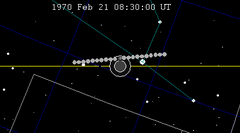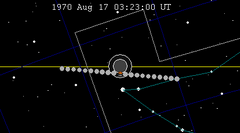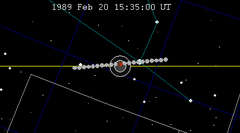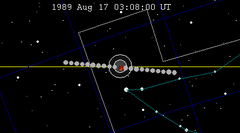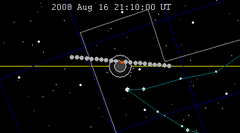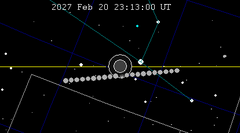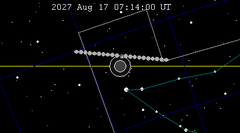|
February 2027 lunar eclipse
A penumbral lunar eclipse will occur at the Moon’s descending node of orbit on Saturday, February 20, 2027,[1] with an umbral magnitude of −0.0549. A lunar eclipse occurs when the Moon moves into the Earth's shadow, causing the Moon to be darkened. A penumbral lunar eclipse occurs when part or all of the Moon's near side passes into the Earth's penumbra. Unlike a solar eclipse, which can only be viewed from a relatively small area of the world, a lunar eclipse may be viewed from anywhere on the night side of Earth. Occurring about 1.5 days after perigee (on February 19, 2027, at 11:45 UTC), the Moon's apparent diameter will be larger.[2] VisibilityThe eclipse will be completely visible over Africa, Europe, and west, central, and south Asia, seen rising over North and South America and setting over east Asia and western Australia.[3]
Eclipse detailsShown below is a table displaying details about this particular solar eclipse. It describes various parameters pertaining to this eclipse.[4]
Eclipse seasonThis eclipse is part of an eclipse season, a period, roughly every six months, when eclipses occur. Only two (or occasionally three) eclipse seasons occur each year, and each season lasts about 35 days and repeats just short of six months (173 days) later; thus two full eclipse seasons always occur each year. Either two or three eclipses happen each eclipse season. In the sequence below, each eclipse is separated by a fortnight.
Related eclipsesEclipses in 2027
Metonic
Tzolkinex
Half-Saros
Tritos
Lunar Saros 143
Inex
Triad
Lunar eclipses of 2024–2027This eclipse is a member of a semester series. An eclipse in a semester series of lunar eclipses repeats approximately every 177 days and 4 hours (a semester) at alternating nodes of the Moon's orbit.[5] The penumbral lunar eclipse on July 18, 2027 occurs in the next lunar year eclipse set.
Saros 143It is part of Saros cycle 143. Metonic seriesThis is the last of five Metonic lunar eclipses. The Metonic cycle repeats nearly exactly every 19 years and represents a Saros cycle plus one lunar year. Because it occurs on the same calendar date, the Earth's shadow will in nearly the same location relative to the background stars.
Half-Saros cycleA lunar eclipse will be preceded and followed by solar eclipses by 9 years and 5.5 days (a half saros).[6] This lunar eclipse is related to two partial solar eclipses of Solar Saros 150.
See alsoReferences
External links
|
||||||||||||||||||||||||||||||||||||||||||||||||||||||||||||||||||||||||||||||||||||||||||||||||||||||||||||||||||||||||||||||||||||||||||||||||||||||||||||||||||||||||||||||||||||||||||||||||||

























